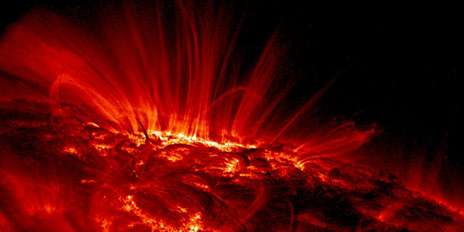Why global warming is taking a break

The average temperature on Earth has barely risen over the past 16 years. ETH researchers have now found out why. And they believe that global warming is likely to continue again soon.
Global warming is currently taking a break: whereas global temperatures rose drastically into the late 1990s, the global average temperature has risen only slightly since 1998 – surprising, considering scientific climate models predicted considerable warming due to rising greenhouse gas emissions. Climate sceptics used this apparent contradiction to question climate change per se – or at least the harm potential caused by greenhouse gases – as well as the validity of the climate models. Meanwhile, the majority of climate researchers continued to emphasise that the short-term 'warming hiatus' could largely be explained on the basis of current scientific understanding and did not contradict longer term warming.
Researchers have been looking into the possible causes of the warming hiatus over the past few years. For the first time, Reto Knutti, Professor of Climate Physics at ETH Zurich, has systematically examined all current hypotheses together with a colleague. In a study published in the latest issue of the journal Nature Geoscience, the researchers conclude that two important factors are equally responsible for the hiatus.
El Niño warmed the Earth
One of the important reasons is natural climate fluctuations, of which the weather phenomena El Niño and La Niña in the Pacific are the most important and well known. "1998 was a strong El Niño year, which is why it was so warm that year," says Knutti. In contrast, the counter-phenomenon La Niña has made the past few years cooler than they would otherwise have been.
Although climate models generally take such fluctuations into account, it is impossible to predict the year in which these phenomena will emerge, says the climate physicist. To clarify, he uses the stock market as an analogy: "When pension funds invest the pension capital in shares, they expect to generate a profit in the long term." At the same time, they are aware that their investments are exposed to price fluctuations and that performance can also be negative in the short term. However, what finance specialists and climate scientists and their models are not able to predict is when exactly a short-term economic downturn or a La Niña year will occur.
Longer solar cycles
According to the study, the second important reason for the warming hiatus is that solar irradiance has been weaker than predicted in the past few years. This is because the identified fluctuations in the intensity of solar irradiance are unusual at present: whereas the so-called sunspot cycles each lasted eleven years in the past, for unknown reasons the last period of weak solar irradiance lasted 13 years. Furthermore, several volcanic eruptions, such as Eyjafjallajökull in Iceland in 2010, have increased the concentration of floating particles (aerosol) in the atmosphere, which has further weakened the solar irradiance arriving at the Earth's surface.
The scientists drew their conclusions from corrective calculations of climate models. In all climate simulations, they looked for periods in which the El Niño/La Niña patterns corresponded to the measured data from the years 1997 to 2012. With a combination of over 20 periods found, they were able to arrive at a realistic estimate of the influence of El Niño and La Niña. They also retroactively applied in the model calculations the actual measured values for solar activity and aerosol concentration in the Earth's atmosphere. Model calculations corrected in this way match the measured temperature data much more closely.
Discover the latest in science, tech, and space with over 100,000 subscribers who rely on Phys.org for daily insights. Sign up for our free newsletter and get updates on breakthroughs, innovations, and research that matter—daily or weekly.
Incomplete measured data
The discrepancy between the climate models and measured data over the past 16 years cannot solely be attributed to the fact that these models predict too much warming, says Knutti. The interpretation of the official measured data should also be critically scrutinised. According to Knutti, measured data is likely to be too low, since the global average temperature is only estimated using values obtained from weather stations on the ground, and these do not exist everywhere on Earth. From satellite data, for example, scientists know that the Arctic region in particular has become warmer over the past years, but because there are no weather stations in that area, there are measurements that show strong upward fluctuations. As a result, the specified average temperature is too low.
Last year, British and Canadian researchers proposed an alternative temperature curve with higher values, in which they incorporated estimated temperatures from satellite data for regions with no weather stations. If the model data is corrected downwards, as suggested by the ETH researchers, and the measurement data is corrected upwards, as suggested by the British and Canadian researchers, then the model and actual observations are very similar.
Warming to recommence
Despite the warming hiatus, Knutti is convinced there is no reason to doubt either the existing calculations for the climate activity of greenhouse gases or the latest climate models. "Short-term climate fluctuations can easily be explained. They do not alter the fact that the climate will become considerably warmer in the long term as a result of greenhouse gas emissions," says Knutti. He believes that global warming will recommence as soon as solar activity, aerosol concentrations in the atmosphere and weather phenomena such as El Niño naturally start returning to the values of previous decades.
More information: Huber M, Knutti R: Natural variability, radiative forcing and climate response in the recent hiatus reconciled. Nature Geoscience, online publication 17 August 2014, DOI: 10.1038/ngeo2228
Journal information: Nature Geoscience
Provided by ETH Zurich




















